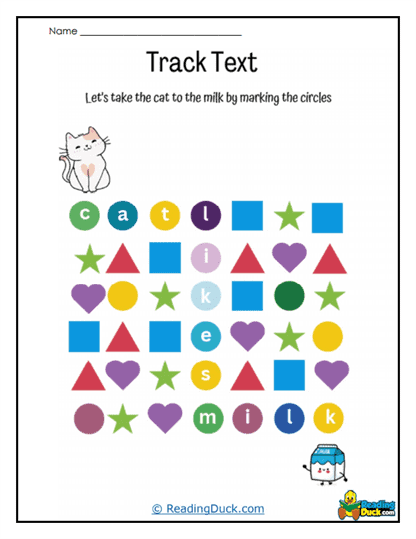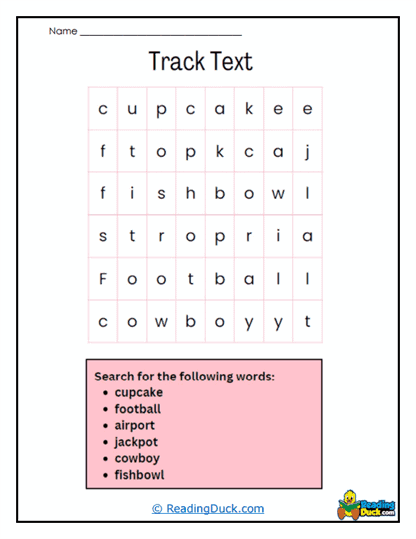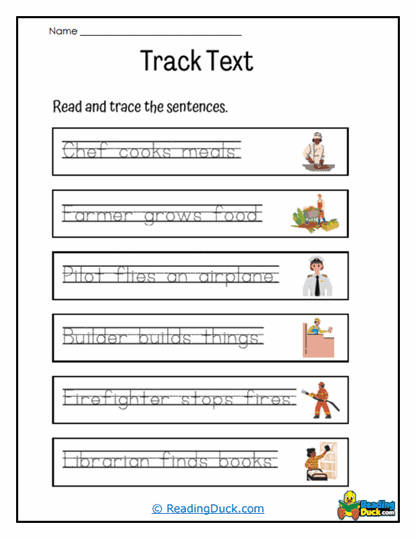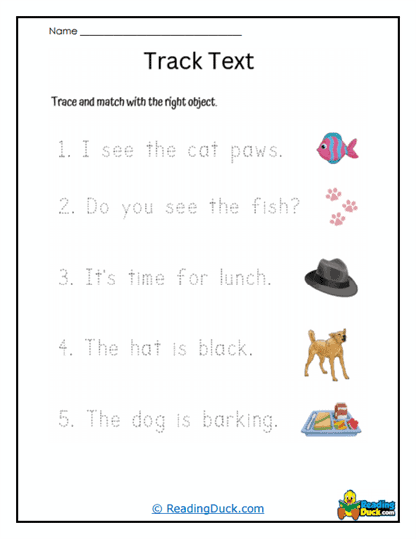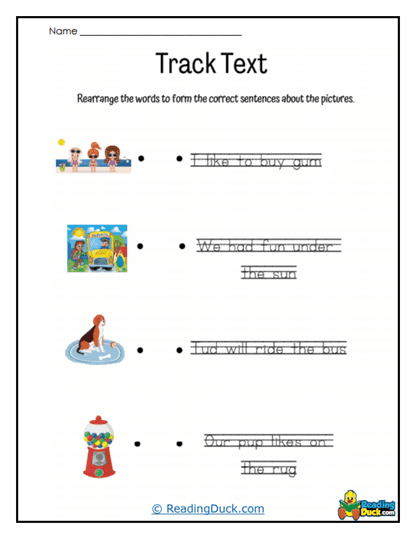Tracking Text Worksheets
About Our Tracking Text Worksheets
Our collection of Tracking Text Worksheets is designed to engage young learners through a variety of tracing activities that build foundational literacy skills. These worksheets primarily focus on tracing sentences but also offer additional activities that enrich the learning experience. For example, some worksheets may include tasks like matching pictures to sentences or completing a word search, all of which serve to reinforce the core skills being developed.
Each worksheet is available in a convenient PDF format, making it easy to view electronically, download, and print. This flexibility allows educators and parents to use these worksheets in various settings, from traditional classrooms to homeschooling environments, ensuring that young learners have access to high-quality resources that support their literacy development.
What Are Tracking Text Worksheets?
Tracking Text Worksheets are educational tools designed to help young learners develop essential literacy skills through the practice of tracing sentences and engaging in related activities. These worksheets guide students as they trace over letters, words, and sentences, helping them to understand the mechanics of writing and the structure of written language.
The concept behind tracking text is simple yet powerful. By having students follow the text with their fingers or a writing utensil, these worksheets help them internalize the left-to-right directionality of English text, the spacing between words, and the alignment of text on a page. This tactile interaction with the text is particularly beneficial for early readers, as it reinforces their understanding of how written language works.
In addition to tracing sentences, Tracking Text Worksheets often include supplementary activities that enhance comprehension and engagement. For example, matching pictures to sentences requires students to connect the visual representation of an idea with its written form, deepening their understanding of the text. Similarly, word search activities can reinforce vocabulary and word recognition skills by encouraging students to identify and circle words within a grid of letters.
Overall, Tracking Text Worksheets are an effective tool for building the foundational skills necessary for reading and writing. They offer a structured and engaging way for students to practice these skills, making them an invaluable resource for early literacy education.
Building Essential Literacy Skills
The Tracking Text Worksheets are crafted to develop key literacy skills in young learners, particularly those in the initial stages of reading development. Tracing sentences serves multiple educational purposes, each of which contributes to a student's ability to read and comprehend text effectively. Here’s a closer look at what these worksheets aim to teach:
- Print Awareness: Understanding that text is read from left to right and from the top to the bottom of a page is fundamental to reading. Tracing sentences helps students internalize these concepts, laying the groundwork for print awareness. This skill is crucial for recognizing that printed text has a specific structure and directionality, which is essential for reading fluency.
- Letter Formation and Handwriting: Through the repetitive action of tracing, students develop fine motor skills necessary for forming letters correctly. Consistent practice with these worksheets helps students improve their handwriting, making their writing clearer and more legible. This skill is important not just for writing but also for overall academic performance, as clear handwriting is essential for effective communication.
- Word Recognition: As students trace sentences, they become familiar with common words and phrases, particularly high-frequency words that appear often in early reading materials. This repeated exposure helps students recognize these words quickly and accurately, which is a key component of reading fluency. Word recognition is essential for building the speed and confidence needed to read independently.
- Comprehension Skills: Some of the worksheets include activities like matching pictures to sentences, which require students to comprehend the meaning of the sentences in order to complete the task. This practice helps students improve their ability to understand and interpret written text, a critical skill for reading comprehension. As students progress, this skill will enable them to make sense of more complex texts and to engage with the material on a deeper level.
- Visual-Motor Integration: The process of tracing sentences supports the development of visual-motor integration, which is the coordination of visual input with motor actions. This skill is vital for tasks that require precise movements, such as writing, drawing, and even certain sports. Improving visual-motor integration helps students perform better in a variety of activities, both academic and recreational.
- Sentence Structure Awareness: Tracing full sentences, rather than individual words or letters, introduces students to basic sentence structures. This practice helps them understand how words come together to form coherent sentences, which is an important step toward writing their own sentences and eventually creating longer texts. Understanding sentence structure is also crucial for comprehension, as it enables students to parse the meaning of sentences more effectively.
By focusing on these key aspects of literacy development, Tracking Text Worksheets provide a comprehensive and effective approach to early reading and writing education. They serve as a foundational tool that supports the broader goal of helping students become confident and capable readers and writers.
Practical Tips for Using Tracking Text Worksheets
These versatile worksheets can be adapted for use in various educational settings, offering numerous opportunities for reinforcing literacy skills. Here are some practical tips on how to make the most of these worksheets:
- Classroom Centers: Implement these worksheets as part of literacy centers in the classroom, where students can work independently or in small groups. This setup allows teachers to provide differentiated instruction, catering to the specific needs of each student while others engage in meaningful practice.
- Homework Assignments: Incorporate these worksheets into weekly homework packets. Parents can easily access the PDFs, print them, and guide their children through the tracing activities, reinforcing what has been taught in school and providing additional practice at home.
- Morning Work: Use these worksheets as morning work to help students transition into the school day. This activity not only reinforces literacy skills but also sets a calm and focused tone for the day ahead.
- Supplemental Practice: For students who need extra help with handwriting or sentence structure, these worksheets can serve as supplemental practice. They provide a structured, low-pressure way for students to build confidence and improve their skills.
- Group Activities: Encourage collaboration by using the worksheets in group activities. For example, students can work together to trace sentences and then take turns reading them aloud. This approach fosters teamwork while reinforcing the literacy skills being practiced.
- Grade Levels: Tracking Text Worksheets are particularly well-suited for Pre-K through 1st-grade students. They are designed to support the early stages of literacy development, making them ideal for young learners who are just beginning to read and write. These worksheets can also be beneficial for older students who may need additional support in these areas.
Enhancing Academic and Personal Development
Tracking Text Worksheets play a significant role in the academic and personal development of young learners. By consistently engaging with these worksheets, students develop a range of skills that are essential for their success in school and in life:
- Confidence in Reading: As students become more proficient in tracing sentences, their confidence in their reading abilities grows. This increased confidence often leads to a greater interest in reading, which is crucial for ongoing literacy development and academic success.
- Attention to Detail: The precision required in tracing sentences helps students develop attention to detail. This skill is important not only for literacy but also for other academic subjects and everyday tasks, where accuracy is key.
- Perseverance: Tracing can be a challenging task, particularly for young learners who are still developing fine motor skills. By working through these challenges, students build perseverance and learn the value of practice and persistence in achieving their goals.
- Independence: As students become more familiar with the worksheets and the skills they are practicing, they gain the confidence to work independently. This sense of independence is important for their overall academic growth, as it encourages self-directed learning and responsibility.
- Preparation for Future Learning: The skills developed through these worksheets lay a strong foundation for more advanced literacy tasks. As students progress through their education, the abilities they have honed through tracing sentences will support their success in reading, writing, and beyond.
In conclusion, Tracking Text Worksheets offer a comprehensive approach to early literacy education. They not only strengthen essential reading and writing skills but also contribute to the overall academic and personal development of young learners. These worksheets are a valuable resource for any educational setting, providing the tools necessary for students to build a strong foundation in literacy and to thrive in their academic journey.
